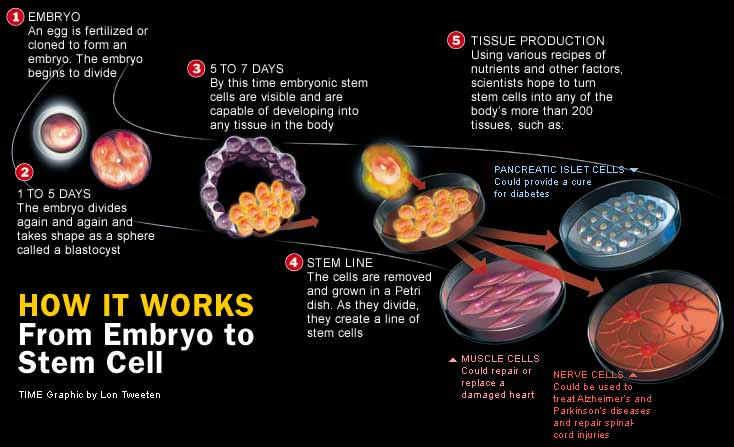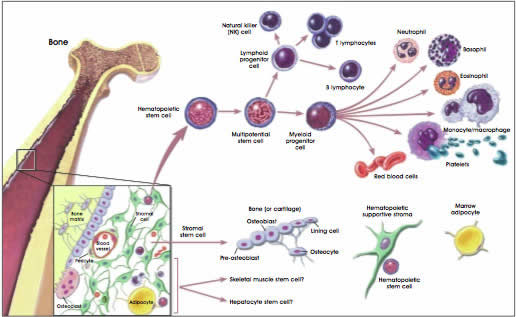Stem cells
出自KMU Wiki
Basic Ideas of Stem Cells
Stem cells have the remarkable potential to develop into many different cell types in the body. Serving as a sort of repair system for the body, they can theoretically divide without limit to replenish other cells as long as the person or animal is still alive. When a stem cell divides, each new cell has the potential to either remain a stem cell or become another type of cell with a more specialized function, such as a muscle cell, a red blood cell, or a brain cell.
I. Introduction
Research on stem cells is advancing knowledge about how an organism develops from a single cell and how healthy cells replace damaged cells in adult organisms. This promising area of science is leading scientists to investigate the possibility of cell-based therapies to treat disease, which is often referred to as regenerative or reparative medicine.
II. What are stem cells and why are they important?
Stem cells have two important characteristics that distinguish them from other types of cells. First, they are unspecialized cells that can renew themselves for long periods through cell division. The second is that under certain physiologic or experimental conditions, they can be induced to become cells with special functions''''such as the beating cells of the heart muscle or the insulin-producing cells of the pancreas and also the nerve cells in our bodies. Scientists primarily work with two kinds of stem cells from animals and humans: embryonic stem cells and adult stem cells, which have different functions and characteristics. Scientists discovered ways to obtain or derive stem cells from early mouse embryos more than 20 years ago. Many years of detailed study of the biology of mouse stem cells led to the discovery, in 1998, of how to isolate stem cells from human embryos and grow the cells in the laboratory. These are called human embryonic stem cells. The embryos used in these studies were created for infertility purposes through in vitro fertilization procedures and when they were no longer needed for that purpose, they were donated for research with the informed consent'''' of the donor. Stem cells are important for living organisms for many reasons. In the 3- to 5-day-old embryo, called a blastocysts, stem cells in developing tissues give rise to the multiple specialized cell types that make up the heart, lung, skin, and other tissues. In some adult tissues, such as bone marrow, muscle, and brain, discrete populations of adult stem cells generate replacements for cells that are lost through normal wear and tear, injury, or disease. It has been hypothesized by scientists that stem cells may, at some point in the future, become the basis for treating diseases such as Parkinson's disease, diabetes, and heart disease.
III. What are embryonic stem cells?
Embryonic stem cells are stem cells, which are derived from embryos. In precise, they are derived from embryos that developed from eggs that have been fertilized in vitro and for the purpose of research with the informed consent from the donors. They are NOT derived from embryos in a woman body. The embryos from which human embryonic stem cells are derived are typically four or five days old and are a hollow microscopic ball of cells called the blastocyst. The blastocyst includes three structures: the trophoblast, which is the layer of cells that surrounds the blastocyst; the blastocoel, which is the hollow cavity inside the blastocyst; and the inner cell mass, which is a group of approximately 30 cells at one end of the blastocoel. In short, embryonic stem cells is the most original stem cell in our bodies and have the greatest potential of specialization, i.e can specialize into nearly any cells in our body.
IV. What are adult stem cells?
An adult stem cell is an undifferentiated cell found among differentiated cells in a tissue or organ, can renew itself, and can differentiate to yield the major specialized cell types of the tissue or organ. The primary roles of adult stem cells in a living organism are to maintain and repair the tissue in which they are found. Some scientists now use the term somatic stem cell instead of adult stem cell. Unlike embryonic stem cells, which are defined by their origin (the inner cell mass of the blastocyst), the origin of adult stem cells in mature tissues is unknown. In short, adult stem cells serve as a natural repair system in our bodies by differentiating into some specialized cells of the tissue or organ in which they are located.
(adult stem cells in bone marrow)
V.Conclusion
Scientists want to study stem cells in the laboratory so they can learn about their essential properties and what makes them different from specialized cell types. As scientists learn more about stem cells, it may become possible to use the cells not just in cell-based therapies, but also for screening new drugs and toxins and understanding birth defects. However, as mentioned above, human embryonic stem cells have only been studied since 1998. Therefore, in order to develop such treatments scientists are intensively studying the fundamental properties of stem cells, which include:
1. determining precisely how stem cells remain unspecialized and self renewing for many years; and
2. identifying the signals that cause stem cells to become specialized cells.
Reference
stemcells.nih.gov/info/basics


